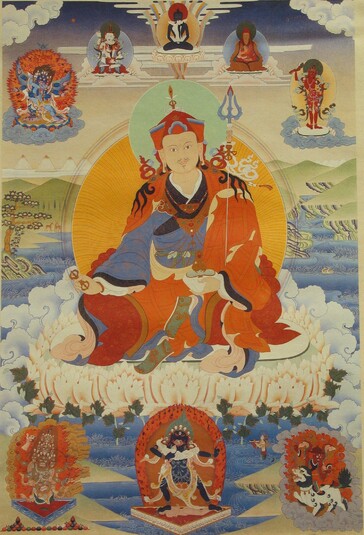
Item: Padmasambhava - (Main Form)
| Date Range | 1960 - |
|---|---|
| Collection | Private |
Padmasambhava (Tibetan: pe ma jung ne. English: Lotus Born): also known as Guru Rinpoche (Precious Teacher). (See Padmasambhava Life-story Painting).
 Pemasambhava
Pemasambhava  Pema Jungne
Pema Jungne  Biographical Details
Biographical Details
With a steady composure gazing on all beings, he has one face adorned with a moustache and goatee, the right hand holds a gold vajra. The left hand placed in the lap holds a white skullcup filled with nectar and a long-life vase. The ornate katvanga staff of a Vajrayana mendicant decorated with white streamers rests against the left shoulder. Adorned with gold earrings and a necklace, the head is covered with a lotus hat, a gift of the King of Zahor, of silk brocade topped with a half-vajra and a single vulture feather. Attired in various robes of different colours reflecting the disciplines of the Vinaya, Bodhisattva and Mantra Vehicles, he sits atop a white lotus blossom rising from the blue waters of Dhanakosha lake; encircled by a radiant sphere.
At the top center is the primordial buddha Samantabhadra, black in colour, naked, with the two hands placed in the lap and seated in vajra posture; embraced by the consort Samantabhadri. To the left is white Vajrasattva with consort. A Tibetan Lama sits on the right side wearing a red pandita hat and monastic robes. Below that on the left is the meditational deity Vajrakila and on the right Vajrayogini, Dechen Gyalmo.
At the bottom center is the principal protector deity for the 'Terma' Treasure Tradition, Ekajati. On the left is Rahula and on the right is Dorje Legpa riding a snow lion.
One of the three principal individuals credited with bringing Buddhism to Tibet in the 8th century, Padmasambhava has since taken on deity and god-like status. He has numerous appearances representing outer, inner and secret aspects of his spiritual being. Within the Oral (Kama) Tradition of the Nyingmapa School of Tibetan Buddhism, Padmasambhava was born in Northern India as the son of a king or minister. In the Treasure (Terma) Tradition he was born on a lotus in Dhanakosha lake as an emanation of the Buddha Amitabha. There is also evidence that Padmasambhava came from South India and that he was the brother-in-law of the Indian Abbott Shantirakshita, builder of the first monastery in Tibet.
Jeff Watt 12-2008
Contemporary Traditional: New Composition (Traditional)
Padmasambhava Main Page
Padmasambhava: Main Form (Vajra at the Knee)
Collection: Private 1
